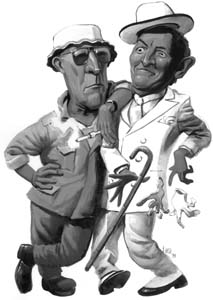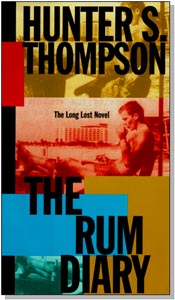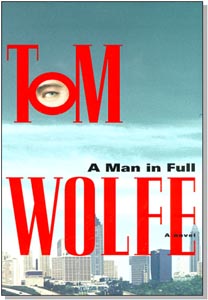![[Metroactive Books]](/books/gifs/books468.gif)
[ Books Index | Metro | Metroactive Central | Archives ]
Going, Going, Gonzo
The Man in Full
Hunter S. Thompson's first novel and Tom Wolfe's newest chart the diverging fortunes of New Journalism's biggest heroes
By Michelle Goldberg
BACK IN THE 1960s and '70s, the literary hierarchy--like so much else in American society--went all topsy-turvy. Suddenly journalists, those ink-stained hacks on the lowest wrung of the intellectual ladder, staged a cultural coup. Reporters challenged the primacy of fiction, demanding respect as writers. And macho cowboy Hunter S. Thompson roared into the thicket of the turmoil.
In Fear and Loathing in Las Vegas, Thompson declared his epochal intention to take readers on "a savage journey into the heart of the American dream." Fear and Loathing in Las Vegas was a novelistic quest, but it gained much of its power from its claim to be a magazine assignment gone feral. Not a parable, not an allegory, not a myth--this nightmare was real.
That's all over now. The era's famed journalists shifted to "pure" fiction--often with brilliant results--and the old order was restored: novelists on top, critics in the middle, reporters down low. Thompson became a kind of joke, a self-parody--a gun-toting, cigarette-smoking, drug-taking loony: Dr. Gonzo, a.k.a. Uncle Duke. He was absorbed into the pop-culture lexicon, including Doonesbury references, a Hollywood biopic (Where the Buffalo Roam) and a high-profile adaptation of Fear and Loathing in Las Vegas. As a writer, however, Thompson was off the map.
Much of his downfall was probably Thompson's own drug-crazed fault. "It's a pretty classic story. Time and time again in the history of literature, writers have grabbed drink or drugs in favor of doing the work," says Roger Black, who knew Thompson in Los Angeles in 1972 and later worked with him at Rolling Stone, where Black was the art director.
"Hunter is one of those guys who wanted the lifestyle and the art all mixed up together," Black says. "It may be impossible for him to separate them. Most of us who knew Hunter 20 years ago can't even believe he's still alive."
But the legend of Thompson's chemical excesses shouldn't obscure his astonishing writing and his hand in creating the New Journalism. "He was clearly one of the geniuses of that era," Black asserts.
A Beast of Himself
THAT'S WHY it's a strange bit of literary synchronicity that Thompson should release his long-lost first novel, The Rum Diary, at the same time that fellow New Journalism pioneer Tom Wolfe has published his long-awaited second, A Man in Full.
While Wolfe's book has been received with raptures by the mainstream media, Thompson's has been largely ignored. But The Rum Diary reminds us of the brutal, pugilistic power of Thompson's prose, a power that put his earlier work in a class with the venerated Wolfe. Begun in 1959, when Thompson was 22, The Rum Diary is a raw, intense account of desperation, hedonism and debauchery--but it also has soul.
The epigraph to Fear and Loathing in Las Vegas reads, "He who makes a beast of himself gets rid of the pain of being a man." In The Rum Diary, Thompson has not yet turned himself into the beast he'd later become. But although The Rum Diary is ostensibly fiction, the novel also traces a kind of blueprint for Dr. Gonzo, as if Thompson had invented his own legend and then set about living up to it.
As the novel begins, Paul Kemp, a vaguely dissolute, cynical reporter, arrives in San Juan to take a job on a third-rate English-language paper. In his own desultory way, Kemp tries to be decent, and he fails.
Thompson paints Puerto Rico as a sweltering den of hustlers, losers and psychopaths. The patterns that would stamp Thompson's later work are all here--Kemp's relationship with a maniacally violent fellow reporter, Yeamon, parallels that of Thompson and his monstrous attorney in Fear and Loathing in Las Vegas.
Yeamon's debauchery allows Kemp to cast himself as the put-upon straight man. It's a dynamic Thompson would repeat throughout his career. In Fear and Loathing in Las Vegas, Thompson manages the keen trick of posing as the horrified professional even when pumped full of mescaline, acid, ether, alcohol and more, because his attorney is the real terror. Such relationships amp up each of his books, forcing the audience to forget any baseline standards of normal behavior.
The Rum Diary is driven by escalating paranoia and the idea of the journalist as outlaw that Thompson would later make famous. He describes the staff of vagrant, mercenary foreign reporters at the San Juan paper:
THOMPSON'S IMAGE as the gonzo journalist is so far away from the Tom Wolfe figure of the writer as Southern gentleman dandy that it's strange to recall how much the two authors once seemed to have in common. Wolfe and Thompson blazed into the literary limelight at the same time. Stars of the '60s and '70s wave of New Journalism, they reinvented the reportorial voice to suit a tumultuous era.
Along with Truman Capote, Joan Didion, Norman Mailer and others, Wolfe and Thompson rejected the objective pose that then dominated mainstream news. Instead, they applied the techniques of fiction to journalism, creating the nonfiction novel.
"It was vivid, terrific writing," says Byron Dobell, the Esquire editor who edited both Wolfe's The Kandy-Kolored Tangerine-Flake Streamline Baby and the Thompson article that grew into Hell's Angels.
"It was the passionate, poetic voice," Dobell says, "hearing speech as a kind of poetry, seeing ordinary people almost as if they were comic heroes or tragic heroes."
Thompson's and Wolfe's early books, in fact, almost seem to riff off each other. Wolfe was following Ken Kesey and his Merry Pranksters in The Electric Kool-Aid Acid Test, Thompson the notorious motorcycle gang in Hell's Angels, and since the two groups partied together, the books include the same anecdotes from different perspectives.
Rereading the two books together makes each seem richer. Then there was Fear and Loathing in Las Vegas, an astounding book that seemed like a rebuke to the gee-whiz subcultural tourism that Wolfe brought his readers along for. Wolfe, in his faux-naïf ebullience, invited audiences to marvel at the crazy, day-glo lunacy of his subjects, but he always seemed to stand with the respectable, bemused observer.
But Thompson, in his gonzo mode, stopped aligning himself with the middle-class reader. In Fear and Loathing in Las Vegas, he rubbed readers' noses in druggy depravity. "Every now and then when your life gets complicated and the weasels start closing in, the only real cure is to load up on heinous chemicals and then drive like a bastard from Hollywood to Las Vegas," he wrote in a famous passage that anticipates his demented 1972 election coverage.
Thompson took the New Journalism a step beyond the nonfiction novel by reporting his hallucinations as reality. "The woman's face," he writes about a hotel clerk, "was changing: swelling, pulsing ... horrible green jowls and fangs jutting out, the face of a Moray Eel! Deadly poison!"
Thompson made readers take for granted heroically destructive levels of abuse and self-abuse as almost the only rational response to the vicious banality of middle-class life.
"He was trying to describe an American nightmare, not unlike what Norman Mailer was doing. They both saw America as really sick, sick beyond recovery," says David Littlejohn, a critic and professor of journalism at UC-Berkeley.
"Thompson was describing America as depraved and decadent. His fantasy sequences--nightmares of a city totally controlled by depraved monsters--he saw as a way of communicating what America felt like," Littlejohn says. "Both Thompson and Mailer have been accused of just describing the inside of their own heads. That's possibly true, but that doesn't mean they weren't right. There are times when only sick people can see the surrounding sickness because everyone else is in denial."
THAT CAREENING, exaggerated form of journalism didn't originate in the 1960s--much of it is inspired by the wildness of 19th-century journalism. "Many journalists in the 19th century were famous for their bombastic, even prejudiced, deeply personal voices," says Tom Leonard, author of The Power of the Press: The Birth of American Political Reporting and News for All.
"A hundred years ago," Leonard explains, "there were more newspapers that wanted to give readers a good read with bright and enticing writing. Another tradition from that time is that of hoaxing the public. Often in the 19th century, editors were willing to publish stories that were sort of tall tales, jokes--'Let's see if we can fool people.' One of the things that Hunter Thompson has always reacted against was the stuffiness and would-be professionalism of journalism, and if you look at 19th-century American journalism, it was neither stuffy nor professional."
Leonard also sees newspaperman H.L. Mencken as Thompson's antecedent: "Mencken was very acerbic and opinionated, and he attacked the American people as a bunch of numbskulls. In the '20s, when people asked him why he stayed in America instead of going into exile in Paris at the time when Hemingway and Fitzgerald did, his answer was 'Why do people go to the zoo?' He was also a defender of the illegal drug of his time, alcohol."
Unlike his colleagues, Thompson never really became a literary insider, nor did he make a midcareer move to fiction. Wolfe, meanwhile, shifted both focus and genre. His attention shifted from youth culture to the upper classes in the article "Radical Chic" and then, most famously, in the novel The Bonfire of the Vanities.
In his latest book, a 742-page behemoth, Wolfe tries to squeeze the whole country into a single volume. A Man in Full is full of Southern real-estate developers, slick lawyers, college football stars, brutal prisoners, gangsta rap, trophy wives, illegal Asian immigrants, et alia. It aims to be both a panorama and a cross-section, much like the sprawling novels of Dickens, Balzac or Thackeray.
Thompson, meanwhile, has never really attempted an epic, and in the wake of the '70s his interests stopped colliding with the fascinations of the larger culture. Sure, he covered elections and politics, but after Fear and Loathing in Las Vegas, he never again found a story that summed up an era as Wolfe did in the '80s with The Bonfire of the Vanities.
The Rum Diary is no exception--it's a very powerful book, but it's about a world that most readers will never encounter and may never hear about again. After Fear and Loathing in Las Vegas, Thompson stopped trying to write the Great American anything.
Which is why, perhaps, the two writers' careers diverged so sharply. "Tom moved into other realms. He moved into middle-class realms, and Thompson always stayed with the proletariat," Dobell says. "People are interested in kings, not peasants. You're interested in the death of a king; you're not interested in the death of some motorcycle maniac." Dobell himself is a perfect example--after working on the "Hell's Angels" piece, he never felt compelled to read Thompson again.
Of course Thompson has a devoted cult following, especially among kids who think--or thought--they know "bad craziness" firsthand. Roger Black, for instance, read the first installment of Fear and Loathing in Las Vegas in Rolling Stone when he was living in Houston. Sick with anticipation to read the rest, he rushed to Big City News, the Houston store that got the magazine before all the others did.
"I stood in line at 7 in the morning--which was pretty amazing for me--and there were 20 other people there waiting for the truck," he recalls. "Everybody wanted to be a stoned-out radical on their way to Las Vegas."
Killer Crocodiles
DESPITE HIS FANS' devotion, though, Thompson's reputation as a writer seems less secure than his reputation as a gun-loving freak, and his work did decline dramatically after Fear and Loathing in Las Vegas. He became too much a true believer in his own gonzo legend. Books like 1989's Generation of Swine provide little more than the gaseous fulminations of a burnout. He should have seen it coming--since he diagnosed the same problem among the Hell's Angels when they became momentarily fashionable in the mid-'60s.
"For nearly a year I had lived in a world that seemed, at first, like something original," he wrote in Hell's Angels. "It was obvious from the beginning that the menace bore little resemblance to its publicized image, but there was a certain pleasure in sharing the Angels' amusement at the stir they'd created. Later, as they attracted more and more attention, the mystique was stretched so thin that it finally became transparent.
Thompson mocked the media's mindless glorification of thuggery, but when that glorifying spotlight settled on him, he let his own furious style turn into shtick. Thompson wrote this incisive paragraph before he had adopted his own outsider uniform--aviator glasses and cigarette holder--and become the patron saint of the drugged and disaffected. And it was, of course, before Johnny Depp was playing him in the movies.
In Generation of Swine, Thompson loots shipwrecks off the coast of Florida, manages a porn theater, riffs--a lot--on the stuff he sees on TV and makes vague allusions to adventurous jobs in far-off places. But unlike Fear and Loathing in Las Vegas and Hell's Angels, these savage journeys never really go anywhere--they seem like jokes.
That's why it may be a good thing that Thompson's new book is an old novel instead of another laborious installment of gonzo. Because, above all, The Rum Diary is a reminder that before he was an icon, Thompson was a wild and powerful writer.
Dobell notes that in 50 years, no one will remember in what order a writer's books appeared. With luck, readers will remember Thompson not only as the lurching wreck portrayed by Johnny Depp in the Fear and Loathing film but also as the author of at least three great books.
"No doubt about it, Fear and Loathing is gonna last forever," says Roger Black. Even when Thompson's notoriety has faded, people will remember that at its best, his writing had an indomitable, explosive gonzo brilliance.
[ San Jose | Metroactive Central | Archives ]
Copyright © Metro Publishing Inc. Maintained by Boulevards New Media.
![]()

The Rum Diary
By Hunter S. Thompson
Simon & Schuster; 304 pages; $24 cloth
By Tom Wolfe
Farrar Strauss & Giroux; 742 pages; $28.95
 There's a deep sense of sadness and fatigue in The Rum Diary--a level of introspection almost wholly absent from Thompson's journalism. Although Thompson was in his early 20s when he wrote the novel, Kemp is worn out and disillusioned: "There was an awful suspicion in my mind that I'd finally gone over the hump, and the worst thing about it was that I didn't feel tragic at all, but only weary, and sort of comfortably detached."
There's a deep sense of sadness and fatigue in The Rum Diary--a level of introspection almost wholly absent from Thompson's journalism. Although Thompson was in his early 20s when he wrote the novel, Kemp is worn out and disillusioned: "There was an awful suspicion in my mind that I'd finally gone over the hump, and the worst thing about it was that I didn't feel tragic at all, but only weary, and sort of comfortably detached."
They were professionally deviant, but they had a few things in common. They depended, mostly from habit, on newspapers and magazines for the bulk of their income; their lives were geared to long chances and sudden movement; and they claimed no allegiance to any flag and valued no currency but luck and good contacts.
Heinous Chemicals Wolfe at the Door
Wolfe at the Door
Tom Wolfe will read from his work on Sunday (Dec. 6) at 4pm at Kresge Auditorium, Stanford; call for ticket information; 650/324-4321.
From the December 3-9, 1998 issue of Metro.